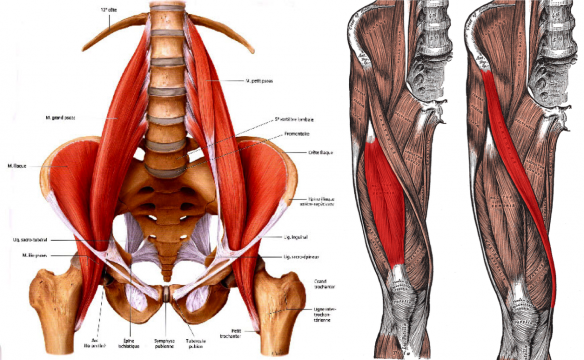Flexion (drawing the legs towards the trunk or making your bicep pop, for example) is a primary piece of our fear response and human beings are a terrified bunch.
This fear manifests in the pelvis through a chronic shortening or engagement of muscles and keeps us stuck in a state of constant alarm.
Our body flexes and extends and rotates and we are forever searching for balance in the front, back and sides of the body to allow for these movements to be successful. The search is all too often in vain.
One common place of imbalance is the hip flexors— yesterday’s post was Your Poor Quadriceps, about one of these muscles but well the same goes for the others as well.
The hip flexors of the title are the three muscular options for bringing the leg closer to the trunk.
With good posture and movement patterns, they all work together endlessly in the course of your day.
Sartorius is the longest muscle in the body and I’m sure that I am being naive when I call it fairly inconsequential.
It begins on the upper rim of the pelvis crossing the thigh to attach to the inside of the knee. Long and thin it gets a functional assist from the femur bone with which it articulates.
In addition to its role as a hip flexor, the sartorius abducts (pulls away) and laterally rotates the hip, and helps with knee flexion.
Picking up your foot to look at the bottom of your shoe displays the sartorius in action.
Of the three hip flexors, Psoas major is the strongest and the only one that connects to the spine.
Iliospas is the meeting of the psoas major muscle and the iliacus. The iliacus lines the wall of the pelvis before forming a common tendon with the psoas major to connect at the lesser trochanter, a small bump of bone on the back half of the inner thigh.
The psoas major connects along the lower spine. We think the psoas is the most important muscle in the body—it holds us up, walks us through life, and warehouses the trauma we can’t deal with in the moment.
Rectus femoris is one of the four quadriceps muscles and though it is a hip flexor, poor postural alignment renders it moot in my book (the same goes for psoas and Sartorius for that matter).
All four of the quadriceps meet to form the patella tendon connecting to the shin below the knee.
Rectus femoris connects to the pelvis which makes it a hip flexor while the other three muscles of the quadriceps (the vastus), acts to stabilize the knee in extension.
Healing comes with knowledge and the more you know about your body and the way it works, the easier and more likely it will be to change patterns that might have been hindering you your whole life.
The hip flexors can hold you back or make your motor hum. Good posture and happy hip flexors allow for a body that welcomes the fear response only to process it and let it go.

